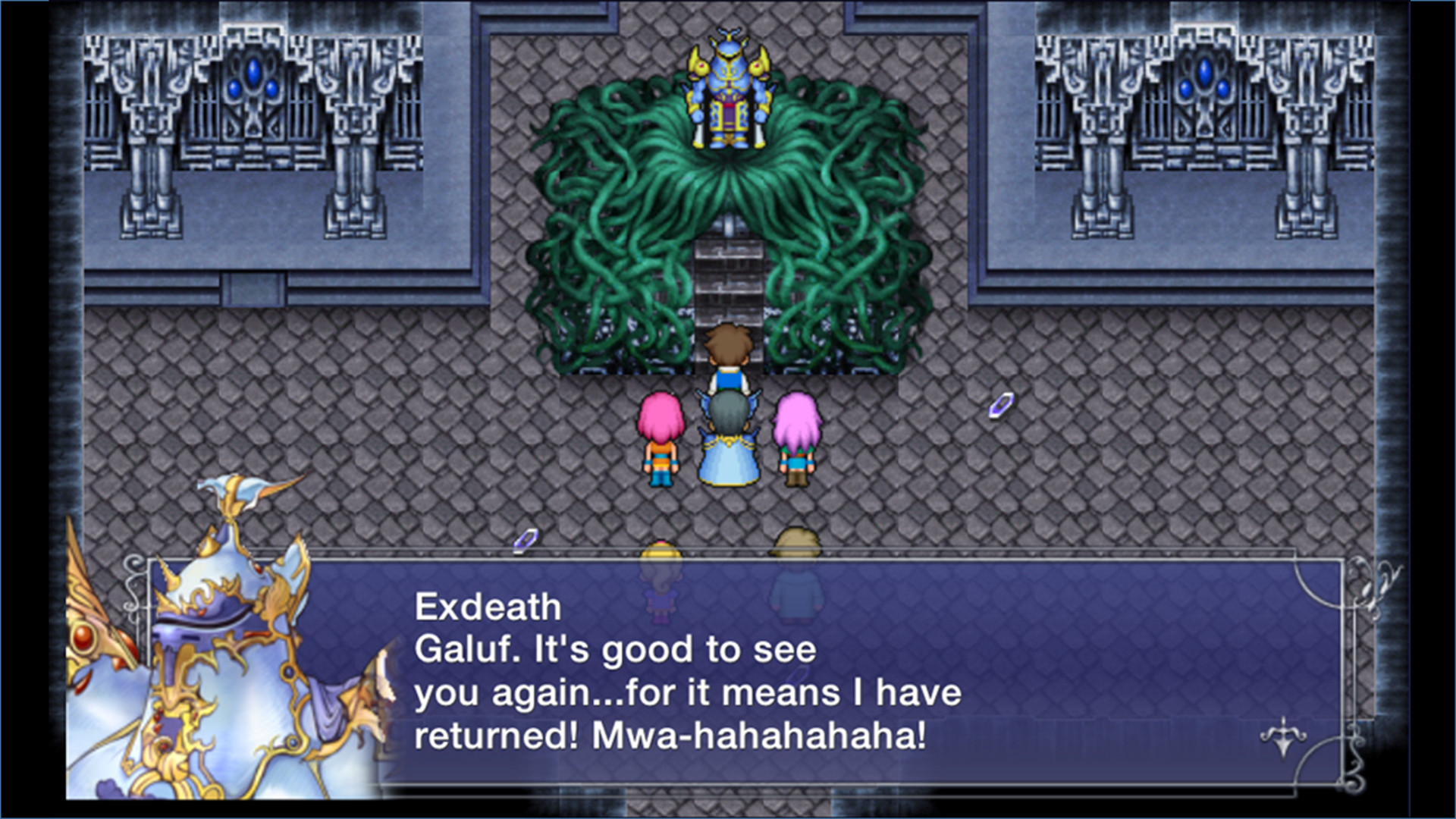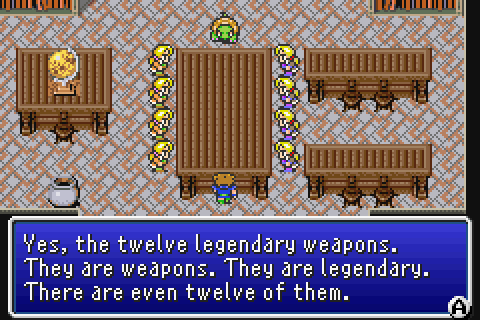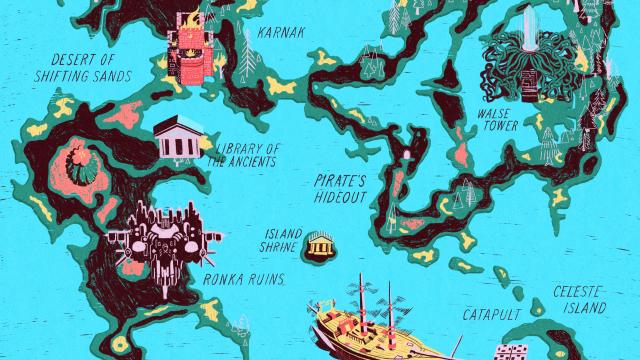Illustration by Angelica Alzona
Final Fantasy V, a video game about four warriors who get together and beat up a giant tree, doesn’t try particularly hard to be innovative. In fact, it doesn’t try at all. Final Fantasy V is essentially an enhanced version of Final Fantasy III, proving rather definitively that Final Fantasy games don’t have to be original to be great.
Like its older brother on the Famicom, Final Fantasy V puts you in control of four Heroes of Light, each of whom can swap between a variety of classes (or, in Final Fantasy parlance, “jobs”). To learn how to use these classes, your heroes chase down crystals based on the four elements: fire, wind, water, earth. There are multiple worlds. The setting fuses medieval fantasy with steampunk technology. There are towns, shops, dungeons, and chocobos. There are gimmicky dungeons and elaborate puzzles. The bards still suck.
This is part five of Kotaku’s Final Fantasy Retrospective, in which we take a look back at every mainline FF game.
Final Fantasy V even followed the FFIII tradition of not actually coming out in North America because Square thought it was too difficult for us dumb gaijin. (With Final Fantasy IV, they’d released a dumbed-down version of , calling it “Easytype” in Japan.) Western gamers wouldn’t get to play an official version of FFV until the sluggish PlayStation port in 1999’s Final Fantasy Anthology.
We wouldn’t get to play a proper version until Final Fantasy V Advance in 2006, which to this day remains the definitive port. (Washed-out graphics and hideous fonts prevent the iOS and PC versions from qualifying.)
Yet somehow, Final Fantasy V has endured among western gamers, to the point where some have organised a popular charity event just to play through it every year. This resilience speaks to how good Final Fantasy V really is. During the charity event, Four Job Fiesta, each participant has to play through the game with four random classes. That this makes for a fun and engaging way to play Final Fantasy V is testament to the robustness of both the combat and job systems.
I wish I had played Final Fantasy V in the 90s, so I’d remember it as fondly as the Final Fantasys that came before and after it. I think that, if the Squaresoft of old had been a little less parochial, we might remember FFV among the all-time greats.

It’s tragic that Square chose to release this version on PC and iOS rather than the superior Game Boy Advance port.
The story: A guy named Bartz — or, by some translations, Butz, which we’ll just take a second to think about and then leave alone — sees a giant meteorite fall from the sky. After investigating, he discovers a princess (Lenna) and an amnesiac old man (Galuf). They meet up with a pirate leader (Faris), and the four soon-to-be heroes find themselves wrapped up in a dimension-spanning quest to save the four crystals.
See, the world of Final Fantasy V, like the world of most Final Fantasy games, relies upon these crystals for warmth and sustenance. The wind crystal controls the winds, the earth crystal prevents the land from imploding, and so on. As it turns out, these crystals also form a seal on an ancient sorcerer named Exdeath (who, as you can probably tell, is evil.
The evil sorcerers never have names like Frank.) The crystals all get shattered, and your party has to chase down and defeat Exdeath before he destroys the world.
Final Fantasy V’s more interesting stories are on a micro level, as the party traverses through a gauntlet of bizarre and fascinating locations. There’s a fire-powered ship, a library where monsters hide in all of the books, a village full of werewolves, and lots of other creative places. There’s plenty of fun slapstick, too, and FFV is generally good about not taking itself too seriously.
The main villain: Exdeath, an imposing warlock who is best known for actually being a giant tree. As a being of pure, boring evil, he lacks the panache of Kefka and the tragic history of Sephiroth, but at least he looks cool.
The gimmick: The job system! Final Fantasy introduced us to character classes. Final Fantasy III expanded them and allowed you to change jobs at any time. Final Fantasy V takes things one step further, letting each character equip a secondary set of abilities on top of their current set of skills. So Bartz can be a White Mage with Ninja abilities. Galuf can be a Ranger who also summons monsters. Faris can be a Bard — well, don’t be a Bard. (Even if Romeo’s Ballad is super OP.)
What’s great about this system is that it allows you to play the game in thousands of different ways. You can challenge yourself or find creative methods of abusing the system. You can run Final Fantasy V with four Time Mages, build a balanced party of knights and mages, or just destroy every boss in the game with nothing but Ninjas. Unlike Final Fantasy III, FFV rarely forces you to play one particular way — the fun is in strategising and customising to take out each of the (rather challenging) bosses in whatever way suits you best.
Best obligatory sacrifice: Following in the footsteps of Tellah before him, Galuf challenges the evil, hulking, superpowered bad guy to one-on-one combat, then dies. At least Galuf’s sacrifice actually means something, helping the rest of the party escape from a nasty Exdeath trap. And his granddaughter’s still alive, so Galuf – 2; Tellah – 0.
Best way to kill a character without making you feel like you wasted time levelling up all his jobs: Replace him with his granddaughter! As soon as Galuf dies, Krile swoops in and takes his place — along with all of his mastered jobs and abilities — so really, his death isn’t even inconvenient for the player.
The best character: Gilgamesh, obviously. A recurring boss and comic relief villain who eventually grows to respect your party, Gilgamesh is an iconic character and the best series tradition that Final Fantasy V brought to the table.
The best non-Gilgamesh character: Ghido the wise-arse sage turtle.

Screenshot via LPArchive
The worst character: Bartz, a dumbass whose personality traits can be summed up as “loves 2 adventure” and “had a sad childhood.” Fortunately, you can turn Bartz into a killing machine with the job system, so he’s not THAT terrible. He’s just no Cecil. Or Terra. Or Cloud. Or even Squall.
The best dungeon: Fork Tower, a late-game dungeon that splits your party into two groups and assigns each group to a different branch of the tower. (Get it? Fork Tower?) One branch is full of enemies that can only be harmed by magic; the other branch is full of enemies that can are only weak to physical attacks. It’s a super-difficult dungeon and makes for a nice change of pace.
Fun fact: Although most people remember Gogo as a hidden party member in Final Fantasy VI, his first appearance was actually as a boss in Final Fantasy V, which suggests that FFVI’s Gogo isn’t Daryl after all. Gogo might just be… Gogo.
Cid has a grandson now: His name is Mid. Cid and Mid help you maintain your airship. This should not be surprising to anyone.
The best piece of music: It’s gotta be Battle on the Big Bridge, although the main theme ranks up there with the best of Nobuo Uematsu’s work.
Best boss: Did I already say Gilgamesh? Really, there are a ton of great bosses in Final Fantasy V, which is yet another reason that this game has endured despite Square’s localisation stumbles. There’s the hand made out of fire, the bird-lizard that swaps weaknesses on the fly, the giant gaping demon mouth… I think my favourite is Necrophobia, just because of how you take him down.
Does the game still hold up? Absolutely! Final Fantasy V’s take on the job system is one of the best to date, and it’s by far the strongest of the “old-school” Final Fantasy games. Play the GBA version, if you can.
One last thing: There’s not a ton to say about Final Fantasy V. It’s a straightforward adventure that hits pretty much every beat you’d expect from a Final Fantasy game, from the giant collection of summon monsters to the weird hidden sidequests.
It’s also the last Final Fantasy directed by Hironobu Sakaguchi, although he’d remain as a “producer” on every Final Fantasy game until 2003, so it’s likely he had his hands on future games as well. Still, Final Fantasy V marked the end of an era — the First Age of Final Fantasy — and future games would ditch series traditions in favour of wild experiments, sometimes for the worse but usually for the way, way better, as we’ll see with the next game.
Next up: One of the greatest video games of all time.

Comments
7 responses to “Final Fantasy V Retrospective: Wildly Underrated”
Easily the best SNES Final Fantasy. There’s just no competition.
You may be forgetting that VI was on the SNES as well.
V>IV>VI
I vote Chrono Trigger as best Final Fantasy on the SNES.
It’s true.
Much is said about FFV job system but there was a game which took that system a notch higher and perfect it, Final Fantasy Tactics. When FFT is discussed, people often remember the awesome story, the dark themes and the difficulty, but the thing that kept me playing and playing for hundreds of hours was the job system.
I really enjoyed all three FF Tactics, but it’s just not the same.